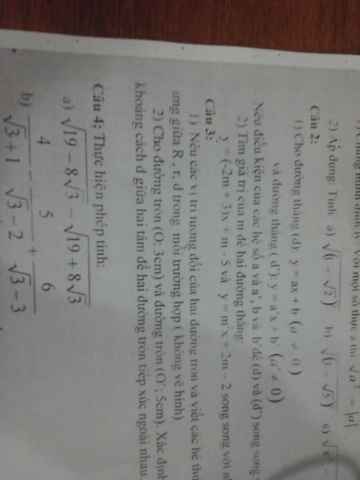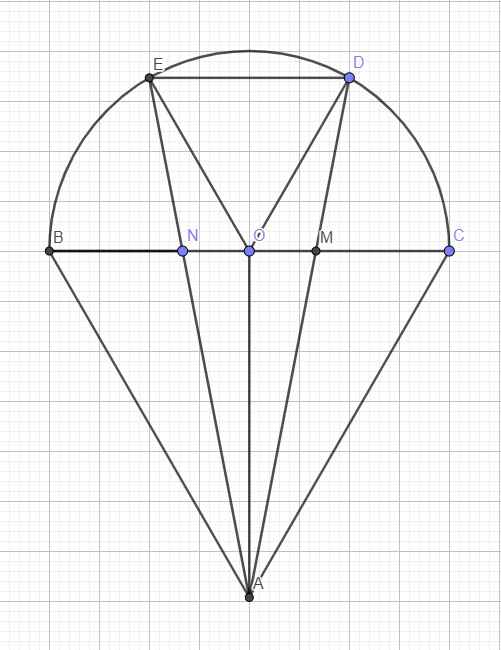
Hãy nhập câu hỏi của bạn vào đây, nếu là tài khoản VIP, bạn sẽ được ưu tiên trả lời.


Gọi O là tâm đường tròn \(\Rightarrow\) O là trung điểm BC
\(\stackrel\frown{BE}=\stackrel\frown{ED}=\stackrel\frown{DC}\Rightarrow\widehat{BOE}=\widehat{EOD}=\widehat{DOC}=\dfrac{180^0}{3}=60^0\)
Mà \(OD=OE=R\Rightarrow\Delta ODE\) đều
\(\Rightarrow ED=R\)
\(BN=NM=MC=\dfrac{2R}{3}\Rightarrow\dfrac{NM}{ED}=\dfrac{2}{3}\)
\(\stackrel\frown{BE}=\stackrel\frown{DC}\Rightarrow ED||BC\)
Áp dụng định lý talet:
\(\dfrac{AN}{AE}=\dfrac{MN}{ED}=\dfrac{2}{3}\Rightarrow\dfrac{EN}{AN}=\dfrac{1}{2}\)
\(\dfrac{ON}{BN}=\dfrac{OB-BN}{BN}=\dfrac{R-\dfrac{2R}{3}}{\dfrac{2R}{3}}=\dfrac{1}{2}\)
\(\Rightarrow\dfrac{EN}{AN}=\dfrac{ON}{BN}=\dfrac{1}{2}\) và \(\widehat{ENO}=\widehat{ANB}\) (đối đỉnh)
\(\Rightarrow\Delta ENO\sim ANB\left(c.g.c\right)\)
\(\Rightarrow\widehat{NBA}=\widehat{NOE}=60^0\)
Hoàn toàn tương tự, ta có \(\Delta MDO\sim\Delta MAC\Rightarrow\widehat{MCA}=\widehat{MOD}=60^0\)
\(\Rightarrow\Delta ABC\) đều


Trả lời:
a, \(2\sqrt{45}+\sqrt{5}-3\sqrt{80}\)
\(=2\sqrt{3^2.5}+\sqrt{5}-3\sqrt{4^2.5}\)
\(=2.3\sqrt{5}+\sqrt{5}-3.4\sqrt{5}\)
\(=6\sqrt{5}+\sqrt{5}-12\sqrt{5}=-5\sqrt{5}\)
c, \(\left(\frac{3-\sqrt{3}}{\sqrt{3}-1}-\frac{2-\sqrt{2}}{1-\sqrt{2}}\right):\frac{1}{\sqrt{3}+\sqrt{2}}\)
\(=\left[\frac{\left(3-\sqrt{3}\right)\left(\sqrt{3}+1\right)}{3-1}-\frac{\left(2-\sqrt{2}\right)\left(1+\sqrt{2}\right)}{1-2}\right].\left(\sqrt{3}+\sqrt{2}\right)\)
\(=\left(\frac{3\sqrt{3}+3-3-\sqrt{3}}{2}-\frac{2+2\sqrt{2}-\sqrt{2}-2}{-1}\right).\left(\sqrt{3}+\sqrt{2}\right)\)
\(=\left(\frac{2\sqrt{3}}{2}+\sqrt{2}\right).\left(\sqrt{3}+\sqrt{2}\right)\)
\(=\frac{2\sqrt{3}+2\sqrt{2}}{2}.\left(\sqrt{3}+\sqrt{2}\right)\)
\(=\frac{\left(2\sqrt{3}+2\sqrt{2}\right)\left(\sqrt{3}+\sqrt{2}\right)}{2}=\frac{6+2\sqrt{6}+2\sqrt{6}+4}{2}=\frac{10+4\sqrt{6}}{2}=5+2\sqrt{6}\)



Bài 2a
Xét tam giác ABC vuông tại A, đường cao AH
* Áp dụng hệ thức : \(AH^2=BH.CH\Rightarrow CH=\frac{AH^2}{BH}=\frac{256}{25}\)cm
-> BC = HB + CH = \(25+\frac{256}{25}=\frac{881}{25}\)cm
Áp dụng định lí Pytago của tam giác ABH vuông tại H
\(AB=\sqrt{AH^2+HB^2}=\sqrt{881}\)cm
Áp dụng định lí Pytago tam giác ABC vuông tại A
\(AC=\sqrt{BC^2-AB^2}=18,9...\)cm
Bài 2c
Xét tam giác ABC vuông tại A, đường cao AH
* Áp dụng hệ thức :
\(AH^2=HB.HC=3.4=12\Rightarrow AH=2\sqrt{3}\)cm
Theo định lí Pytago tam giác AHB vuông tại H
\(AB=\sqrt{AH^2+HB^2}=\sqrt{21}\)cm
* Áp dụng hệ thức : \(\frac{1}{AH^2}=\frac{1}{AB^2}+\frac{1}{AC^2}\Rightarrow\frac{1}{12}=\frac{1}{21}+\frac{1}{AC^2}\Rightarrow AC=2\sqrt{7}\)cm



a, \(P=\frac{\sqrt{x}}{\sqrt{x}-1}+\frac{3}{\sqrt{x}+1}-\frac{6\sqrt{x}-4}{x-1}\)ĐK : \(x\ge0;x\ne1\)
\(=\frac{x+\sqrt{x}+3\sqrt{x}-3-6\sqrt{x}+4}{x-1}=\frac{x-2\sqrt{x}+1}{x-1}=\frac{\sqrt{x}-1}{\sqrt{x}+1}\)
b, \(B=\frac{3x-4}{x-2\sqrt{x}}-\frac{\sqrt{x}+2}{\sqrt{x}}+\frac{\sqrt{x}-1}{2-\sqrt{x}}\)ĐK : \(x>0;x\ne4\)
\(=\frac{3x-4-\left(x-4\right)-\sqrt{x}\left(\sqrt{x}-1\right)}{\sqrt{x}\left(\sqrt{x}-2\right)}\)
\(=\frac{3x-4-x+4-x+\sqrt{x}}{\sqrt{x}\left(\sqrt{x}-2\right)}=\frac{x+\sqrt{x}}{\sqrt{x}\left(\sqrt{x}-2\right)}=\frac{\sqrt{x}+1}{\sqrt{x}-2}\)
c, \(Q=\frac{3}{\sqrt{a}-3}+\frac{2}{\sqrt{a}+3}+\frac{a-5\sqrt{a}-3}{a-9}\)ĐK : \(a\ge0;a\ne9\)
\(=\frac{3\sqrt{a}+9+2\sqrt{a}-6+a-5\sqrt{a}-3}{a-9}=\frac{a}{a-9}\)
d, \(B=\frac{x}{x-4}-\frac{1}{2-\sqrt{x}}+\frac{1}{\sqrt{x}+2}\)ĐK : \(x\ge0;x\ne4\)
\(=\frac{x}{x-4}+\frac{\sqrt{x}+2}{x-4}+\frac{\sqrt{x}-2}{x-4}=\frac{x+2\sqrt{x}}{x-4}=\frac{\sqrt{x}}{\sqrt{x}-2}\)













 ĐỀ BÀI: GIẢI HỆ PHƯƠNG TRÌNH. Gíup em với ạ. Em cảm ơn!
ĐỀ BÀI: GIẢI HỆ PHƯƠNG TRÌNH. Gíup em với ạ. Em cảm ơn!
b: Ta có: \(\dfrac{4}{\sqrt{3}+1}+\dfrac{5}{2-\sqrt{3}}-\dfrac{6}{3-\sqrt{3}}\)
\(=2\sqrt{3}-2+10-5\sqrt{3}-3-\sqrt{3}\)
\(=-4\sqrt{3}+5\)